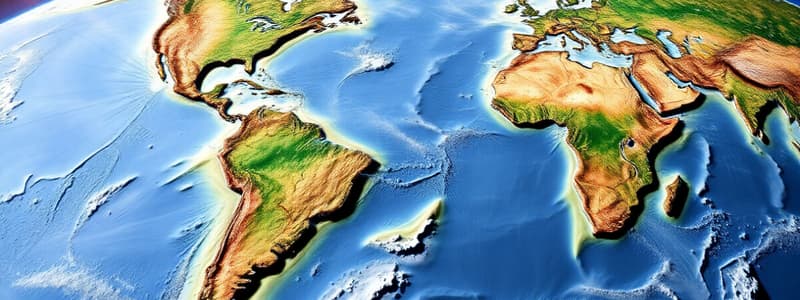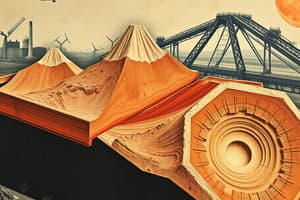Podcast
Questions and Answers
Which layer of the Earth is divided into the upper and lower mantle?
Which layer of the Earth is divided into the upper and lower mantle?
- Outer Core
- Inner Core
- Mantle (correct)
- Crust
The lithosphere is composed of the mantle and the core.
The lithosphere is composed of the mantle and the core.
False (B)
What type of plate boundary movement occurs when two plates slide past each other?
What type of plate boundary movement occurs when two plates slide past each other?
Transform
The sudden movement within the Earth's interior, at the _______, releases energy in the form of seismic waves.
The sudden movement within the Earth's interior, at the _______, releases energy in the form of seismic waves.
Match each item with the corresponding plate tectonic feature or process.
Match each item with the corresponding plate tectonic feature or process.
Which of the following is NOT a major tectonic plate?
Which of the following is NOT a major tectonic plate?
Volcanic eruptions are exclusively caused by movement in the tectonic plates.
Volcanic eruptions are exclusively caused by movement in the tectonic plates.
What is the name of the largest tectonic plate?
What is the name of the largest tectonic plate?
The location on the Earth's surface directly above the origin point of an earthquake is called the ________.
The location on the Earth's surface directly above the origin point of an earthquake is called the ________.
Match each type of seismic wave with its description.
Match each type of seismic wave with its description.
What causes the movement of tectonic plates?
What causes the movement of tectonic plates?
Intensity measures the amount of energy released by an earthquake at its focus.
Intensity measures the amount of energy released by an earthquake at its focus.
What should one do immediately after an earthquake, according to the provided information (besides follow authority instructions)?
What should one do immediately after an earthquake, according to the provided information (besides follow authority instructions)?
Volcanoes located away from plate boundaries are often associated with geological hotspots and characterized by _______ volcanoes.
Volcanoes located away from plate boundaries are often associated with geological hotspots and characterized by _______ volcanoes.
Match the volcanic term to its description:
Match the volcanic term to its description:
Which of the following is a warning sign of an approaching tsunami?
Which of the following is a warning sign of an approaching tsunami?
Tsunamis are caused exclusively by underwater earthquakes.
Tsunamis are caused exclusively by underwater earthquakes.
What is the primary cause of tsunamis?
What is the primary cause of tsunamis?
The Pacific Plate is often referred to as the _______ due to the high frequency of volcanic eruptions.
The Pacific Plate is often referred to as the _______ due to the high frequency of volcanic eruptions.
Match the type of volcano with its characteristics:
Match the type of volcano with its characteristics:
Which of the following factors affects water density?
Which of the following factors affects water density?
Warm air is denser than cool air, causing it to sink.
Warm air is denser than cool air, causing it to sink.
How does a difference in air temperature lead to wind?
How does a difference in air temperature lead to wind?
The spinning of wind in a circular motion, which is caused by different points on Earth moving at different speeds, is known as the ________.
The spinning of wind in a circular motion, which is caused by different points on Earth moving at different speeds, is known as the ________.
Match the hemisphere with the direction of wind rotation due to the Coriolis Effect.
Match the hemisphere with the direction of wind rotation due to the Coriolis Effect.
What percentage of the ocean is controlled by surface currents?
What percentage of the ocean is controlled by surface currents?
Deep ocean currents are primarily driven by wind and tides near the shore.
Deep ocean currents are primarily driven by wind and tides near the shore.
What are gyres?
What are gyres?
The thermohaline circulation, combining deep water and wind-driven surface currents, forms a long winding loop called the _______.
The thermohaline circulation, combining deep water and wind-driven surface currents, forms a long winding loop called the _______.
Associate the current type with its description:
Associate the current type with its description:
Flashcards
Crust
Crust
Outermost layer of the Earth, composed of magma rocks and covering both land and water.
Mantle
Mantle
Second layer of the Earth, divided into a solid upper mantle and a molten lower mantle.
Core
Core
Innermost and hottest layer of the Earth, divided into a molten outer core and a solid inner core.
Lithosphere
Lithosphere
Signup and view all the flashcards
Tectonic Plates
Tectonic Plates
Signup and view all the flashcards
Pacific Plate
Pacific Plate
Signup and view all the flashcards
Continental Drift
Continental Drift
Signup and view all the flashcards
Plate Boundary
Plate Boundary
Signup and view all the flashcards
Convergent Boundary
Convergent Boundary
Signup and view all the flashcards
Divergent Boundary
Divergent Boundary
Signup and view all the flashcards
Transform Boundary
Transform Boundary
Signup and view all the flashcards
Plate Tectonic Theory
Plate Tectonic Theory
Signup and view all the flashcards
Convection Currents
Convection Currents
Signup and view all the flashcards
Geohazards
Geohazards
Signup and view all the flashcards
Earthquakes
Earthquakes
Signup and view all the flashcards
Tectonic Earthquake
Tectonic Earthquake
Signup and view all the flashcards
Volcanic Earthquake
Volcanic Earthquake
Signup and view all the flashcards
Focus
Focus
Signup and view all the flashcards
Epicenter
Epicenter
Signup and view all the flashcards
Magnitude
Magnitude
Signup and view all the flashcards
Intensity
Intensity
Signup and view all the flashcards
Seismic Waves
Seismic Waves
Signup and view all the flashcards
Volcanic Eruptions
Volcanic Eruptions
Signup and view all the flashcards
Crater
Crater
Signup and view all the flashcards
Vent
Vent
Signup and view all the flashcards
Volcanic Ejecta
Volcanic Ejecta
Signup and view all the flashcards
Composite Volcanoes
Composite Volcanoes
Signup and view all the flashcards
Shield Volcanoes
Shield Volcanoes
Signup and view all the flashcards
Volcano
Volcano
Signup and view all the flashcards
Tsunamis
Tsunamis
Signup and view all the flashcards
Study Notes
Plate Tectonic Theories
- The Earth's layers consist of the crust, mantle, and core.
- The crust is the outermost layer, composed of magma rocks and covering both land and water.
- The mantle is the second layer, divided into the upper (solid) and lower (molten) parts.
- The core is the innermost and hottest layer, also divided into a molten outer core and a solid inner core.
- The lithosphere is made up of the upper mantle and the crust.
- The lithosphere is broken into tectonic plates, including 7 major and 8 minor plates.
- The Pacific plate is the largest plate.
- Continental drift occurs as plates move away from each other.
- Plate boundary movements include convergent (towards each other), divergent (away from each other), and transform (sliding past each other).
- Plate tectonic theory explains plate movement and how it causes geohazards.
- Convection currents, driven by heat from the core, cause plate movement.
Geohazards
- Geohazards are dangerous natural events.
- Earthquakes are caused by sudden movements along faults, releasing energy through waves.
- Tectonic earthquakes are caused by movement in tectonic plates and faults, while volcanic earthquakes are due to magma movement.
- The focus is the location inside the Earth where movement begins, while the epicenter is the surface location above the focus.
- Intensity measures the earthquake's effects on people and residences.
- Magnitude measures the strength of the earthquake and energy released.
- Seismic waves transmit energy in various directions and motions.
Earthquake Safety Measures
- Before: Prepare a go-bag, know evacuation routes, and plan with family.
- During: Evacuate, avoid weak structures, stay low, and use "duck, cover, and hold".
- After: Stay in evacuation centers until cleared, and avoid unstable areas.
Volcanic Eruptions
- Many volcanoes are located in the Pacific Plate/Ring of Fire due to convection currents.
- Volcanoes erupt when pressure and gas build up in the magma chamber.
- Composite volcanoes have a crater, vent, secondary cone, and secondary vent.
- Volcanoes eject ash, steam, gases, lava, and volcanic bombs.
- Composite volcanoes are cone-shaped and found on destructive plate margins; shield volcanoes are on constructive margins or hotspots and have gentle slopes.
- Constructive plate margins form volcanoes as magma fills the gap between separating plates.
- Destructive plate margins form volcanoes as the denser oceanic plate melts under the continental plate, releasing gas and pressure.
- Volcano signs may include changes in crater size or temperature, shaking, and increased sulfur dioxide.
- Magma is melted rock from the mantle/crust, and lava is magma that reaches the surface.
Volcano Safety Measures
- Before: Prepare a go-bag, know evacuation routes, and plan with family.
- During: Go to high ground and away from the ocean, and follow authorities.
- After: Stay on high ground until official updates and be prepared for follow-up hazards.
Tsunamis
- Tsunamis are caused by underwater earthquakes or plate movements.
- Tsunamis form when earthquakes displace water, creating a large wave.
- Warning signs include earthquakes lasting over 20 seconds, rapid water level changes, and a loud roar from the ocean.
Tsunami Safety Measures
- Before: Prepare a go-bag, know evacuation routes, and plan with family.
- During: Evacuate, avoid weak structures, stay low, and use "duck, cover, and hold".
- After: Stay in evacuation centers until cleared and avoid unstable areas.
The Moving of the Earth
- Heat and density affect water behavior.
- Cold water is denser and sinks faster.
- Wind results from temperature changes in air molecules.
- Warm air rises, creating low pressure, while cool air sinks, creating high pressure.
- High pressure moves to low pressure, causing wind.
- Earth's rotation includes both rotation on its axis and revolution around the sun (365 days).
- The Coriolis Effect results from different wind speeds at different points on Earth, causing circular motion.
- The Northern Hemisphere rotates in one circular motion, while the Southern Hemisphere rotates in the opposite direction.
Ocean Currents
- Surface currents make up 10% of the ocean and are driven by wind and tides.
- Deep ocean currents make up 90% of the ocean and are influenced by differences in density, temperature, and salinity.
- Gyres are large loops in the water that move due to surface currents.
- Northern Hemisphere gyres move clockwise, while Southern Hemisphere gyres move counterclockwise.
- Thermohaline Circulation involves cold, deep currents sinking and warm, surface currents rising.
- The Global Conveyor Belt is a long, winding loop created by thermohaline circulation and wind-driven surface currents.
- The Global Conveyor Belt transports nutrients and can take water droplets 1000 years to travel its length.
Studying That Suits You
Use AI to generate personalized quizzes and flashcards to suit your learning preferences.




